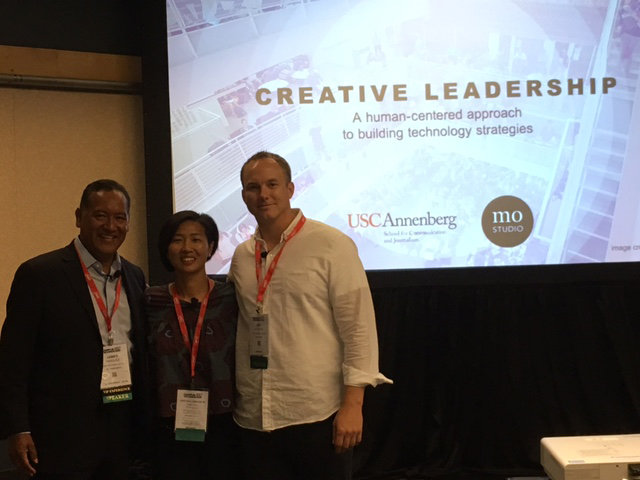Campus Technology 2017: USC Succeeds at Human-Centered Design for Tech
The Annenberg School for Communication and Journalism at the University of Southern California has conducted a student technology survey every year since 2010. But in 2016 it decided to try something new: It hired a firm that specialized in human-centered design to develop better questions, find more effective ways to engage students and hopefully attain new insights.
The plan was a success. Unlike many such surveys, which often elicit little response, the school heard from more than 600 students eager to share their feedback, frustrations and suggestions.
James Vasquez, associate dean and CIO of the school, shared his findings on Wednesday at the Campus Tech conference in Chicago. He co-presented with Jeff Scheire and Sue Tan, partners at Los Angeles-based MO Studio, on “Creative Leadership: A Human-Centered Approach to Building Technology Strategies.”

James Vasquez, associate dean and CIO of the Annenberg School for Communication and Journalism at the University of Southern California; Sue Tan, partner at MO Studio; and Jeff Scheire, partner at MO Studio.
Integrating People, Business and Technology
The insights that USC gains from its annual surveys aren’t for small stakes, Vasquez said. The university uses them to make decisions on infrastructure and investments. But he recognized that their larger purpose needed to evolve. In the past, surveys focused on what devices students brought to campus. But now, he said, IT leaders need a more holistic understanding: “It’s not about the device. It’s about the student experience.”
Enter MO Studio, which works with companies and organizations on research, design and strategic planning around human-centered design. Their approach arises from the belief that the user experience is paramount, Tan said, and organizations that want to improve it need a multi-lens perspective.
Focus, first and foremost, on people: What do users want? What are their actual needs, which might be different from what they think they need? Then, the business perspective: What is viable, profitable and sustainable? And the technology: What is feasible with the tools and resources that are available?
“The key thing is to begin with the ‘people’ lens, because that’s what matters at the end of the day. You can come up with the perfect process, but if people don’t use it or understand it, it fails,” Tan said. “People tend to silo these, but to be truly innovative and effective, everyone needs to take this multi-lens approach.”
A Three-Phase Solution to New Learning
MO Studio’s team collaborated with Vasquez’s team to understand the problem, reimagine a solution and then execute. After substantial research to develop the survey, the team landed on 16 questions, including three open-ended questions.
The partners also considered the best way to engage students, often the most challenging aspect of a tech survey. Vasquez turned to his students for help, asking them how to get their peers to participate.
Their suggestions: Make the engagement quick. Set up tables in common areas with coffee, doughnuts and iPads, so students can take the survey easily. (Tan said her team also captured the informal conversations that happened at such times and included that feedback as well.) The school hired a food truck to come to campus for one day to increase participation. Students edited the outreach email messaging to make it more appealing, with shorter copy and a subject header that read “Free food!” The team even embedded playful language into the survey itself, a move that Vasquez said he initially resisted because he feared it seemed unprofessional, but one that students said made the survey more fun.
Open-ended questions were a huge driver of the survey results, Scheire said: “The data and information we got back from the open-ended questions took us a week to get through.”
Insights Enable USC to Improve User Experience
The team analyzed the quantitative data, synthesized insights and tied everything together in a report that identified areas of opportunity. Perhaps not surprisingly, students’ biggest issue was Wi-Fi access, together with systems they felt were disjointed and low awareness of IT resources. “We want a seamless experience on the tech side” was a major takeaway, Vasquez said.
But the survey also yielded surprises, some of which were easy to address. For instance, USC offered workshops in creative software programs, such as Adobe Photoshop, but what students wanted were workshops in Microsoft Excel. Other workshops aligned with students’ interests, but weren’t offered at times students were available, so the school now schedules workshops on evenings and weekends. The school had created a well-equipped “digital room” on campus, but students didn’t know they were allowed to use it; a “Students Welcome” sign was a simple fix.
Findings fell into buckets of low-hanging fruit, short-term improvements and long-term considerations, said Vasquez, and his team is now working its way through the list. Overall, he said, the focus is on the user experience: “What is it we’re delivering, and why?”
Tips to Put People at the Center of Tech
Tan and Scheire shared advice on developing human-centered technology strategies in higher education:
- See students as both stakeholders and valuable contributors. Involve them early on, not just after the fact. “Students were eager to share their opinions and play an active role” in the survey, Tan said.
- Uncover insights, not just opinions. Focus on “why” as much as “what.”
- Understand the diversity of user types, rather than viewing students as one homogenous population. Allow a range of unique needs and behaviors to inform tailored solutions and a better system for everyone.
- Think of the user journey holistically. Work toward understanding the interrelated touchpoints that make up the end-to-end experience.
- Create a continuous feedback loop. Vasquez and his team shared the survey outcomes with students so they could see the impact of their feedback. That will make them more likely to engage in the future, Scheire said.
Catch more updates from Campus Technology 2017 on EdTech's official event page.









